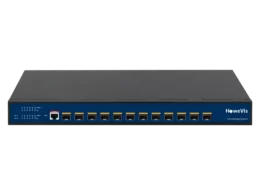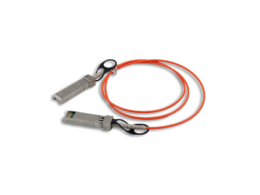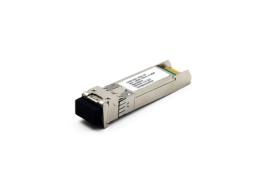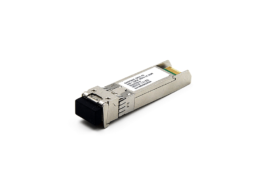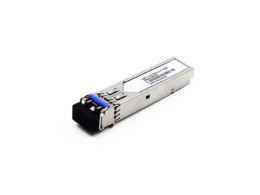Welcome to the world of PoE switches and the intriguing realm of SFP ports. If you’ve ever wondered what an SFP port is in a PoE switch, you’ve come to the right place. These small form-factor pluggable ports are the backbone of network connectivity, providing flexibility and versatility for connecting different types of devices. With support for copper and fiber optic connections, SFP ports allow seamless data transmission without interrupting network performance. Whether setting up a small office network or managing enterprise-level infrastructure, understanding the power of SFP ports is essential.
We’ll explore their benefits, such as hot-swapping modules and supporting various cable types. So, if you’re ready to unlock the potential of SFP ports in your network setup, let’s delve into this fascinating topic together.
Understanding the Significance of SFP Ports in Gigabit Switches
SFP ports, also known as Small Form-Factor pluggable ports, enable gigabit speeds for network connections. These ports offer higher bandwidth than traditional RJ45 ports, allowing faster and more efficient data transmission. Let’s explore the significance of SFP ports in gigabit switches and their advantages.
Enhanced Network Capacity and Flexibility
One key benefit of SFP ports is their ability to upgrade or expand your network capacity effortlessly. With SFP modules, you can easily connect additional devices to your network without any hassle. This flexibility is precious for small office networks or environments where scalability is essential.
Support for Various Protocols
SFP ports are incredibly versatile as they support many protocols,t such as Ethernet, Fibre Channel, and SONET/SDH. This compatibility allows them to integrate with different types of network devices seamlessly and ensures smooth communication between them. Whether dealing with data communications or transferring large files, SFP ports provide support for various applications.
Extended Cable Distances
You can achieve longer cable distances than traditional copper cables. Fiber optic cables connected through SFP ports can transmit data over greater distances without compromising speed or performance. This extended reach makes them ideal for scenarios where devices are located far apart or when connecting multiple buildings within a campus environment.
High-Speed Data Transmission
SFP ports excel at providing high-speed data transmission capabilities that are essential in today’s fast-paced digital world. Whether streaming high-definition videos, playing online games, or handling large-scale data transfers, these ports ensure your network operates efficiently. Combining gigabit switch technology with SFP ports allows seamless connectivity and rapid transfer rates.
Easy Integration with Existing Infrastructure
One of the advantages of SFP ports is their compatibility with fiber optic and copper cables. This means you can easily integrate them into your network infrastructure without replacing all your Ethernet cables. SFP ports provide a smooth transition from traditional copper cables to fiber optic cables, allowing you to leverage the benefits of faster speeds and longer distances.
Cost-Effective Solution
SFP ports offer a cost-effective solution for expanding or upgrading your network. You can add SFP modules to your existing equipment rather than investing in entirely new switches or devices, saving money and reducing the complexity of managing multiple devices. Using fiber optic and copper cables with SFP ports provides flexibility in choosing the most suitable and affordable option for your specific needs.
Exploring the Functionality of SFP Ports in Power over Ethernet (PoE) Technology
SFP ports, also known as Small Form-Factor Pluggable ports, are crucial in networking. Power over Ethernet (PoE) technology.
Simplifying Installation with PoE-enabled SFP Modules
One significant advantage of utilizing SFP ports with PoE technology is the elimination of separate power cables. With PoE-enabled SFP modules, you can power devices such as IP phones, wireless access points, and cameras directly through the Ethernet cable. This simplifies installation and reduces clutter by removing the need for additional power sources.
Industry-Standard Specifications for Power Delivery
Adhering to industry standards is crucial for compatibility and performance. SFP ports that support PoE follow industry-standard IEEE 802.3af/at/bt specifications for power delivery. These standards ensure that devices receive the appropriate amount of power without any compatibility issues or damage risks.
Enhancing Network Efficiency and Reducing Clutter
By integrating PoE capabilities into SFP ports, network efficiency is significantly improved. Traditionally, powering devices required separate electrical outlets or power injectors. However, with PoE-enabled SFP modules, you can conveniently provide data and power through a single Ethernet cable connection.
This simplifies cable management and reduces clutter in your network setup. You can create a cleaner, more organized environment by eliminating extra cables and power sources while ensuring seamless data transmission.
Supporting Various Applications in Different Environments
The versatility of PoE-enabled SFP ports makes them suitable for a wide range of applications across different environments. Powering devices through SFP ports offers flexibility and convenience, Whether in a small office network or an enterprise-level data center.
In small office networks, PoE-enabled SFP ports can connect IP phones, wireless access points, and cameras. This eliminates the need for additional power sources and simplifies the setup process. It is especially beneficial when placing power outlets near each device is impractical or unfeasible.
PoE-enabled SFP ports provide a streamlined solution in larger enterprise environments with interconnected devices. They ensure that devices such as IP phones and wireless access points receive data and power without the hassle of managing separate cables or power sources.
Extending Maximum Distance with Fiber Optic Cables
SFP ports offer the advantage of supporting both copper and fiber optic cables. While copper cables are commonly used for shorter distances, fiber optic cables excel in long-distance data transmission. You can significantly extend the maximum distance between network devices.
Fiber optic cables use light signals instead of electrical signals to transmit data. This allows for faster transmission speeds over longer distances than traditional copper cables. With SFP ports supporting fiber optic connections, you can achieve reliable high-speed data transfer over several kilometers.
Comparing the SFP Port and RJ45 Port on a Gigabit Switch
While both types of ports connect devices to a network, they have distinct characteristics that make them suitable for different scenarios.
Interchangeable Modules vs. Fixed Connectors
Unlike RJ45 ports with fixed connectors, SFP ports offer greater flexibility through interchangeable modules. This means you can easily swap out modules depending on your specific needs. For example, you can insert an appropriate SFP module designed for fiber optic connections if you need to connect your switch to a fiber optic cable. On the other hand, RJ45 ports are commonly used for copper connections and do not require additional modules.
Fiber Optic Capability
One significant advantage of SFP ports is their ability to support fiber optic connections. Using the appropriate SFP module, you can establish high-speed data transmission over long distances using fiber optic cables. This makes SFP ports particularly useful in scenarios requiring long-range communication or environments prone to electromagnetic interference.
Higher Transmission Speeds
Another notable difference between SFP and RJ ports is their maximum data transfer rates. While standard RJ45 ports typically support Gigabit Ethernet speeds (up to 1 Gbps), SFP ports can reach even higher transmission speeds. With technological advancements, some modern switches equipped with SFP28 (25 Gbps) or even faster interfaces provide significantly faster data rates than traditional RJ45-based switches.
Flexibility in Cable Choice
SFP ports offer greater flexibility. Depending on your requirements and infrastructure setup, you can opt for either copper or fiber optic cables with SFP ports. This versatility allows you to adapt your network to different environments and tailor it to suit your needs. On the other hand, RJ45 ports are more commonly used and limited to copper connections.
Distance Considerations
Fiber optic cables with SFP ports have a clear advantage over copper cables typically used with RJ45 ports. Fiber optic cables can transmit data longer distances without experiencing significant signal degradation or loss. SFP ports are ideal for large-scale networks or scenarios where devices are far apart.
Copper or Fiber Optic Cable: Which is Used by an SFP Port?
One key consideration is the type of cable that can be used with it. Depending on the specific network requirements, an SFP port can support both copper and fiber optic cables. Let’s explore the differences between these two types of cables and understand when each is preferred.
Copper Cables for Shorter Distances
Copper cables, or Ethernet cables, are commonly used for shorter distances within a building or small office network. They are widely available and relatively inexpensive compared to fiber optic cables. Copper cables use electrical signals to transmit data, making them suitable for distances up to 100 meters.
One advantage of using copper cables with an SFP port is that they are compatible with existing infrastructure. If you already have copper cabling, you can connect it to an SFP module and utilize the benefits of a PoE switch without replacing your entire network setup.
However, it’s important to note that copper cables have limitations. As the distance increases, signal degradation may occur, leading to slower data transfer rates or even complete loss of connectivity.
Fiber Optic Cables for Longer Distances and High-Speed Connections
On the other hand, fiber optic cables offer superior performance over longer distances and can transmit data at higher speeds. These cables use light signals instead of electrical signals for data transmission, allowing them to achieve excellent bandwidth capabilities.
Fiber optic cables are ideal for applications that require high-speed connections over long distances. They are commonly used in enterprise networks, data centers, and telecommunications infrastructure where maximum performance is essential. With fiber optic cables connected to an SFP port, you can achieve reliable data transmission over several kilometers without experiencing signal degradation.
Choosing the Right Cable for Your Network
The choice between copper or fiber optic cables for an SFP port depends on various factors, including the network topology, distance requirements, and desired performance. Here are a few considerations to help you make an informed decision:
- Distance: Copper cables are suitable for connecting devices within a short distance (up to 100 meters). However, fiber optic cables are the better option if you require connectivity over longer distances (several kilometers).
- Speed: Fiber optic cables can provide the necessary bandwidth if your network demands high-speed data transmission, such as in video streaming or large file transfers. Copper cables may struggle to maintain optimal speeds over long distances.
- Future scalability: Fiber optic cables offer greater scalability and future-proofing than copper cables. As technology advances and data requirements increase, fiber optics provide ample room for growth and can support higher data transfer rates.
It’s worth mentioning that SFP modules compatible with either copper or fiber optics can be used interchangeably in an SFP port. This means you have the flexibility to choose the cable type based on your specific needs without replacing the entire switch or module.
Differentiating Between SFP Fiber and Copper Modules
In a small office network, the choice of modules for your switch’s SFP port can significantly impact performance. There are some key differences that you should be aware of. Let’s dive into differences to help you make an informed decision.
SFP Fiber Modules: High Bandwidth and Long Transmission Distances
SFP fiber modules utilize optical transceivers to convert electrical signals into light signals, which are transmitted through fiber optic cables. These modules offer several advantages over their copper counterparts. Firstly, they provide higher bandwidth capabilities, allowing faster data transmission rates. This makes them ideal for applications that require large amounts of data transfer, such as video streaming or data-intensive tasks.
Another benefit of SFP fiber modules is their ability to support longer transmission distances than copper modules. Fiber optic cables have a much lower signal loss than copper cables, enabling data to be transmitted over greater distances without degradation in quality. This makes them suitable for connecting devices across large areas or between different buildings in a campus environment.
However, it’s important to note that using fiber optic cables may require additional considerations. For instance, due to the specialized equipment and expertise required, the installation and maintenance costs of fiber optic cabling can be higher compared to copper cabling. Compatibility with existing infrastructure should also be considered when using SFP fiber modules.
Copper Modules: Cost-Effective Solution for Shorter Cable Runs
Unlike SFP fiber modules, copper modules transmit electrical signals directly through twisted pair cables. Copper-based solutions are often more cost-effective for shorter cable runs within a building or office space where long distances are unnecessary.
One advantage of copper modules is their ease of installation and familiarity with networking environments. Ethernet cables, commonly used with copper modules, are readily available and can be quickly terminated and connected. This makes them a convenient choice for small networks or home networking setups.
Another consideration when using copper modules is the maximum distance they can support. While fiber optic cables can transmit data over long distances, copper cables have limitations due to signal degradation over longer runs. However, technological advancements have led to higher-grade copper cables supporting faster data rates over shorter distances.
Choosing Between Fiber and Copper Modules
When deciding between SFP fiber and copper modules, several factors include distance, speed requirements, and budget constraints. Here are some key considerations to help you make the right choice:
- Distance: If you need to connect devices over long distances or between different buildings, SFP fiber modules, with their lower signal loss, are the better option.
- Speed Requirements: If your network requires high bandwidth capabilities for tasks like video streaming or large file transfers, SFP fiber modules provide faster data transmission rates.
- Budget Constraints: For shorter cable runs within a building or office space, copper modules offer a more cost-effective solution without compromising performance.
Ultimately, the decision between SFP fiber and copper modules depends on your network requirements. It’s essential to evaluate your needs carefully and consider factors such as maximum distance, data rates, and budget before deciding.
Maximum Link Distance and Device Connectivity with SFP Ports
The SFP port in a PoE switch is crucial for expanding the network’s capabilities. It allows for maximum link distance and device connectivity, making it an essential feature to consider. Let’s explore how SFP ports enable extended link distances and versatile connections.
Maximum Link Distance: Fiber Optic vs. Copper-based SFP Modules
The maximum link distance of an SFP port depends on the type of module used. These ports can achieve link distances ranging from just a few meters to several kilometers, making them ideal for long-range data transmission in various applications. Conversely, copper-based SFP ports have more limited link distances than their fiber-optic counterparts. They are typically designed for shorter distances within a local area network (LAN); therefore, if you require longer link distances.
Device Connectivity: Connecting Various Devices with SFP Ports
SFFP (Small Form-Factor Pluggable) ports equipped with PoE switches allow seamless connection with various devices such as switches, routers, servers, and more. These versatile ports provide multiple connectivity options for different types of networks.
Whether you need to connect your small office network or enterprise-level infrastructure, SFFP ports offer the flexibility to accommodate diverse devices and support efficient data communications.
Network Topology: Supporting Different Types of Networks
SFFP ports are designed to support different network topologies based on your specific requirements. Whether you have a star topology, where all devices are connected directly to a central switch, or a mesh topology, where machines are interconnected in multiple ways, these ports can handle it.
SFFP ports offer compatibility across various network types, connecting via fiber optic and copper cables. You can choose the appropriate SFP transceiver based on your network topology to achieve seamless connectivity.
Maximum Link Distance Variation: Considering Cable Quality
While SFP ports provide excellent link distances, it’s important to note that the maximum length can vary depending on the quality of the cable used. High-quality cables ensure optimal data transmission and reliable connections over longer distances.
To maximize the performance of your SFFP ports, it is recommended to use premium fiber optic cables or high-grade copper cables that meet industry standards. This helps maintain signal integrity and minimize any potential disruptions in data transfer.
Role of SFP Uplink Ports in Network Connectivity
SFP uplink ports are crucial in connecting switches within a network topology. These uplink ports enable high-speed data transfer between switches, ensuring efficient communication between network parts. Let’s delve deeper into the significance and benefits of these uplink ports.
Creating Redundancy and Ensuring High Availability
One of the primary advantages of SFP uplink ports is their ability to create redundancy within a network. If one switch fails, uplink ports provide alternate paths for data transmission, ensuring uninterrupted connectivity. This redundancy enhances network reliability and minimizes downtime, which is critical for businesses that rely heavily on continuous data communications.
Expanding Network Capacity with Ease
As networks grow, they must expand their capacity to accommodate additional devices and users. SFP uplink ports facilitate this expansion by adding more switches to the existing network infrastructure. Organizations can quickly scale their networks without disrupting ongoing operations by connecting new switches through these uplink ports.
Supporting Different Types of Cables
SFP uplink ports offer flexibility. They support fiber optic and copper cables, providing options based on specific requirements and constraints. Fiber optic cables are ideal for long-distance connections as they transmit data over greater distances without signal degradation. On the other hand, copper cables are suitable for shorter distances but offer cost-effective solutions for small office networks or home setups.
Enhancing Data Transmission Speeds
Uplink ports with SFP transceivers support higher data rates than standard Ethernet cables or combo ports. With faster transfer rates such as Gigabit or even 10 Gigabit speeds, these uplink ports ensure swift and efficient data transmission across the network. This is particularly beneficial in scenarios where large amounts of data need to be transferred quickly, such as video streaming, file sharing, or data-intensive applications.
Welcome to the World of SFP Uplink Ports
In today’s fast-paced digital world, SFP uplink ports have become a standard feature in many network switches. Their versatility and performance make them highly sought by customers across various industries. Whether for enterprise-level networks, small office setups, or home networking environments, these uplink ports provide the necessary connectivity and flexibility to meet different application requirements.
Supporting Various Network Topologies
SFP uplink ports are compatible with various network topologies, allowing seamless integration into existing infrastructure. They can be used in star topologies, with multiple switches connected to a central switch, or in daisy-chain configurations, where switches are linked linearly. This versatility ensures that SFP uplink ports can adapt to different network designs and layouts without hassle.
Catering to Different Distances
SFP uplink ports offer support for varying link distances depending on a network’s specific needs. Fiber optic cables connected through these ports can transmit data over long distances, from meters to kilometers. This makes them suitable for scenarios where devices are far apart or connecting different buildings within an enterprise campus. The ability to cater to additional distance requirements adds another layer of flexibility to network design and implementation.
Embraced by Industry Vendors
SFP uplink ports have gained widespread adoption within the networking industry due to their numerous benefits and compatibility with various devices and technologies. Many vendors offer switches equipped with these ports as standard features, ensuring customers have access to reliable and efficient connectivity options. The popularity of SFP uplink ports is reflected in the positive feedback they receive from users worldwide, as evidenced by online forums and communities where users share their experiences and provide helpful insights.
Conclusion: Understanding the Importance of SFP Ports in PoE Switches
Congratulations! You’ve now comprehensively understood the significance of SFP ports in PoE switches. These small form-factor pluggable (SFP) ports are vital in expanding network connectivity options and enhancing device compatibility. By utilizing SFP ports, you can seamlessly integrate different types of devices requiring copper or fiber optic connections.
Now that you know how SFP ports work and what their benefits are, it’s time to put that knowledge to use. Upgrade your network infrastructure with a PoE switch with SFP ports to unlock greater flexibility and scalability. With these versatile ports, you can connect various devices effortlessly, ensuring smooth data transmission and optimal performance.
FAQs
What are the advantages of using SFP ports in a PoE switch?
SFP ports offer several advantages in a PoE switch setup. First, they allow flexible connectivity options by supporting copper and fiber optic cables. Second, SFP modules can be easily swapped or upgraded without replacing the entire switch. This modularity enables future-proofing your network infrastructure while minimizing costs. Third, SFP ports provide extended reach capabilities, allowing longer link distances between devices.
Can I use any SFP module with my PoE switch with an SFP28 port? Ethernet switches often require specific transceiver modules to be compatible with the downlink port.
Most PoE switches are compatible with standard SFP modules. However, to ensure compatibility, it’s essential to check the manufacturer’s specifications. Some switches may have specific requirements or limitations regarding supported modules or maximum power output per port.
How do I determine whether I need an RJ45 or SFP port on my gigabit switch?
The choice between an RJ45 port and an SFP port depends on your requirements. If you need to connect devices using Ethernet cables directly, such as computers or printers, an RJ45 port will suffice. On the other hand, an SFP port is the ideal choice if you require flexibility in terms of cable type or need to connect devices over longer distances with fiber optic cables.
Can I mix copper and fiber optic connections on a PoE switch with SFP ports?
Absolutely! One of the significant advantages of SFP ports is their compatibility with copper and fiber optic cables. You can mix and match these connections based on your network requirements. This versatility allows you to adapt to various devices and environments seamlessly.
Are SFP ports backward compatible with older network equipment?
Yes, SFP ports are designed to be backward compatible. They can work with older network equipment that utilizes Fast Ethernet (10/100 Mbps) or Gigabit Ethernet (1 Gbps) standards. However, ensuring that the speed and duplex settings are configured correctly for optimal performance is essential.
Remember, as you explore the networking world, continue seeking reliable sources for additional information and stay updated on emerging trends. Happy networking!

